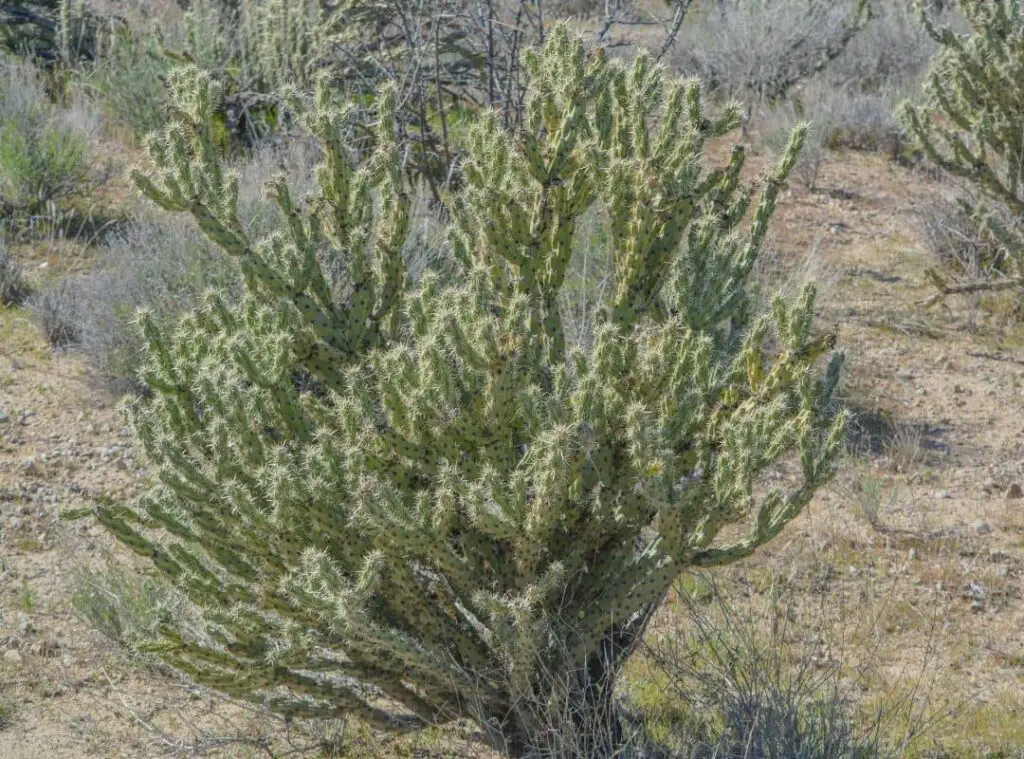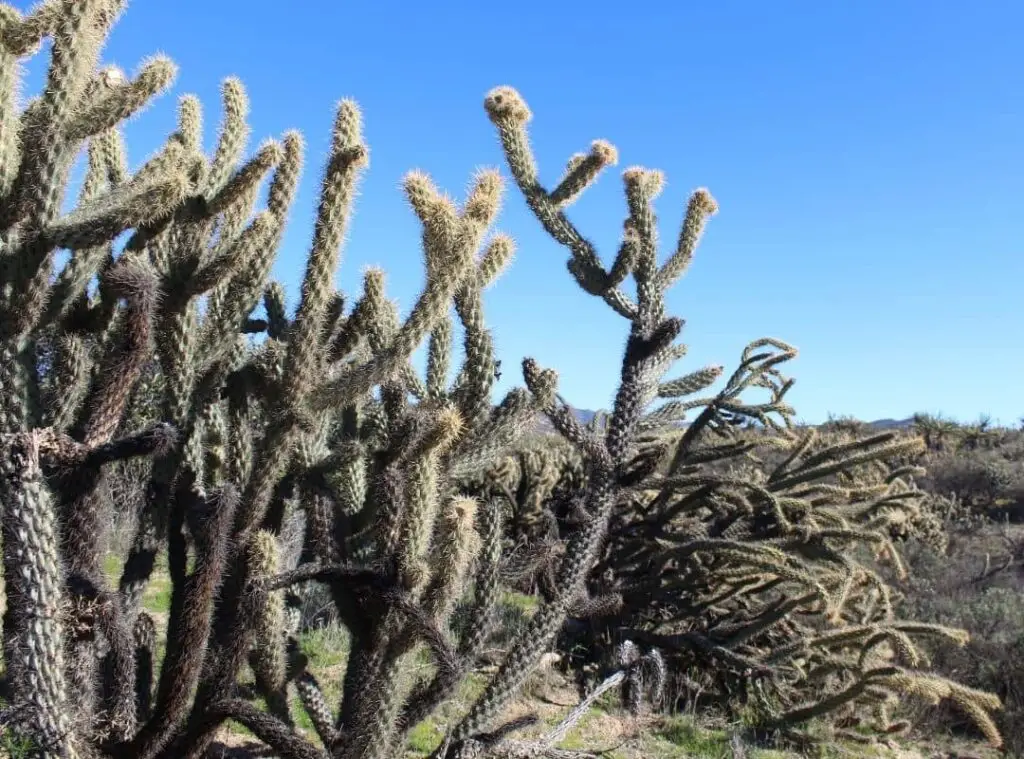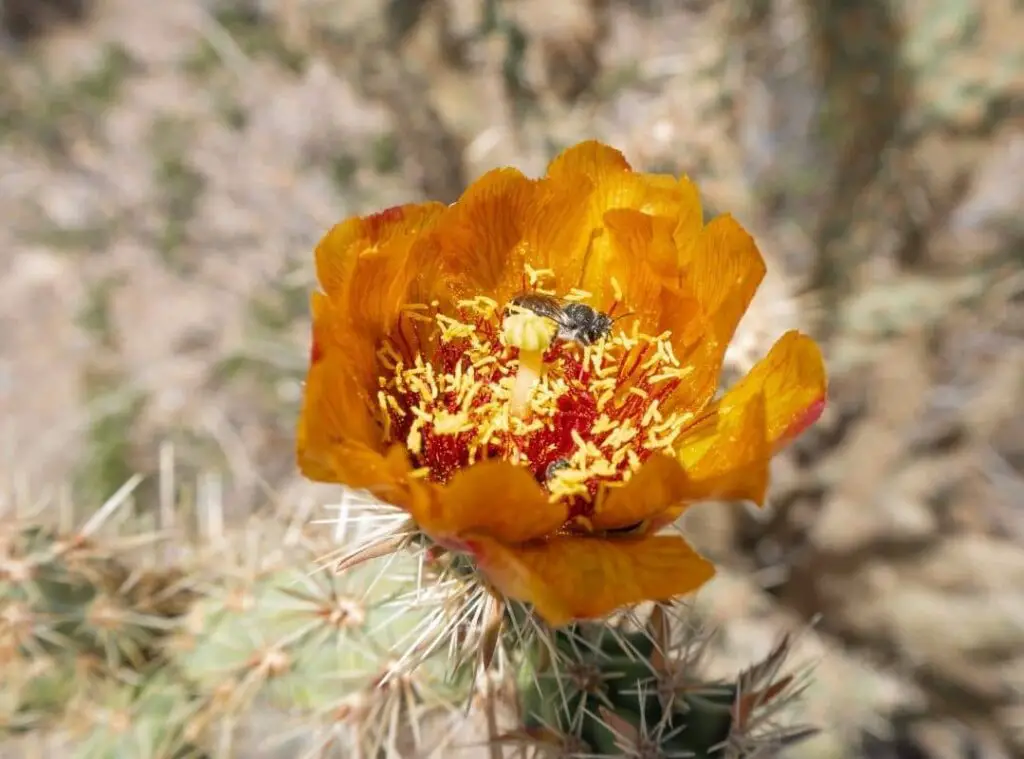Cylindropuntia acanthocarpa are spectacular shrub-type plants which you will find in the USA.
They go by the common name called Buckhorn cholla. Cylindropuntia acanthocarpa are endemic plants to the USA.
They would usually grow in places such as in grasslands, scrublands etc. They produce flowers in pink, red, orange and yellow -green as well.
Cylindropuntia acanthocarpa is a plant you should never hesitate to have. So, if you already own a Cylindropuntia acanthocarpa plant or if you wish to have one of these, it would be worth reading this article.

How do I identify Cylindropuntia acanthocarpa?
Cylindropuntia acanthocarpa usually grows large. They may in fact form as shrub types as well as trees.
They would comprise spines which would tend to look brown. They won’t form too dense on the stem.
As such the stem could look prominent in yellow green and in purple, green in moist conditions and in dry conditions respectively. Cylindropuntia acanthocarpa produces branches profusely.
That gives a somewhat untidy appearance for the whole look of the plants. They may further form slender stems which would come up in different lengths.
If we consider the mature plants, their lower stems would be more woody. In addition to these characteristics, Cylindropuntia acanthocarpa emerge with a spiny fruit as well.
At the start you could spot them in green which would tend to look brown later on. They would grow as tall as 3 feet to 7 feet at maturity
Cylindropuntia acanthocarpa spines would vary in their lengths. In fact, their sizes would vary from 0.5-1.5 inches.
The central spine would be the longest of them. Besides these features, they emerge with flowers in pink, red, orange and yellow green colors.
Size of the plant
Cylindropuntia acanthocarpa would reach a maximum height of 3 – 7 feet.
Growth rate
Cylindropuntia acanthocarpa are a rapidly growing set of plants.
One look care guide
| Botanical Name | Cylindropuntia acanthocarpa |
| Common Name | Buckhorn cholla |
| Plant Type | Cactus |
| Mature Size | Maximum height of 3 feet – 7 feet |
| Sun Exposure | Full sunlight |
| Soil Type | Well draining |
| Soil pH | Neutral |
| Bloom Time | April and May |
| Flower Color | pink, red orange and in yellow green |
| Hardiness Zones | USDA hardiness zone USDA Zone 9a. |
| Native Area | USA |
| Toxicity | No toxic |
| Average price | 7 USD |

How do you take care of Cylindropuntia acanthocarpa?
Light Requirement
Just like the rest of other cacti, Cylindropuntia acanthocarpa would also appreciate a lot of sunlight.
If you grow them outdoors, you need to select a spot where they can gain full sunlight preferably in the morning hours for about six hours of the day.
On the other hand, when you grow them indoors you need to select a spot where they still gain sufficient sunlight.
I suggest planting them by a bright sunny windowsill as it would fulfill the sunlight requirement of them.
With that being said, if the Cylindropuntia acanthocarpa still runs short of sufficient sunlight, you could place grow lights closer to the plants.
Temperature and humidity
Cylindropuntia acanthocarpa are hardy plants. They would want warmer temperatures right throughout the year.
Having said that, they can also stand temperatures which get colder up to 5 degrees Fahrenheit ( -15 degrees Celsius), but not for too long.
Hence, I recommend bringing them indoors if you have placed them outdoors. The optimal temperature which would work well for them would be around 50 degrees Fahrenheit ( 10 degrees Celsius).
A temperature around 70 degrees Fahrenheit and above would be beneficial for the flower blossoming of the Cylindropuntia acanthocarpa.
Is it cold hardy?
Cylindropuntia acanthocarpa are cold hardy up to 5-degree Fahrenheit ( -15 degrees Celsius) for shorter periods.
Growth Zone
Cylindropuntia acanthocarpa grow well outdoors if you grow them in USDA hardiness zone USDA Zone 9a.
Watering Requirement
Watering the Cylindropuntia acanthocarpa is the most important aspect in looking after them. They are drought tolerant plants.
You need to always bear that in mind and one- or two-times forgetting water won’t make a big impact on the health of the plants.
Instead, over watering could be a big problem. In fewer words, under watering would not harm the plants but over watering would do.
To elaborate further, excess water would lead to root rot. If your Cylindropuntia acanthocarpa is already suffering from rot best is to move them out from the other plants.
If you plant Cylindropuntia acanthocarpa freshly you could water them regularly so that they can adjust in the new growing conditions. Once they are well established, you could water them sparingly.
Since these are quite prone towards root rot, you need to always make sure that you let their soil wither between two watering sessions.
Further when watering, you need to do it thoroughly so that it can soak through the soil well. I recommend watering them once every week during their active growing season.
However, if you have planted them in much warmer conditions, you need to water them more often as the water will dry out faster.
If they are passing colder conditions, you don’t have to bother watering them at all. If requirement arises you could consider watering them a little. In terms of the right humidity levels, they will prefer to have moderate humidity levels.

Soil Requirement Type / pH.
When they grow in their natural habitats they would usually grow in dry conditions. As such I recommend growing them in a substrate which would mimic the same conditions they get in their natural habitats.
An excellent drainage in the chosen soil mix is mandatory. In terms of the right ph. level, I recommend you go ahead with an average Ph.
If you wish to, you could make an appropriate soil mix for them. However, if you do not have a lot of time to spare, I recommend going ahead with a commercially available succulent soil mix or with a cactus soil mix.
If you want to further increase the drainage of the soil mix, you could consider adding elements such as grit or sand.
Pot size Potting and Repotting
Many people opt to use plastic or clay pots to grow the Cylindropuntia acanthocarpa plants.
I recommend using plastic pots to grow them if you live in much warmer conditions as they would keep moist for some time within the pot.
On the other hand, you can choose clay pots if you live in much colder conditions as they would help the excess moisture to evaporate faster.
It is very unlikely you would have to go through root rot if you chose clay pots to grow them.
I recommend repotting once every other year.All you have to do is take the plant out from the pot and remove the older soil around the plants and place it in a fresh soil mix and in a fresh pot.
It’s noteworthy to mention that you should wear gloves when you are interacting with the plants. If you keep growing the plants in the same growing conditions for extended periods all the nutrients in the soil mix would have been depleted.
Thus, period repotting would be crucial for the healthy growth of the Cylindropuntia acanthocarpa. Further it will help you to identify if there are any early signs of upcoming diseases as well.
Where to Plant
You may plant Cylindropuntia acanthocarpa in a spot where they can absorb strong sunlight. Further choose the right pot type also as explained in the above.
Fertilizer and time of year
I encourage applying fertilizers for the Cylindropuntia acanthocarpa on a regular basis for the optimal growth of them.
Best is to go ahead with a balanced granular fertilizer which is specifically made for cacti and for succulents.
In addition to that you may also use a diluted water-soluble fertilizer for this purpose. Avoid feeding them in excess as it would result in weak growth of the plants. So, do it with caution.
Flower
Cylindropuntia acanthocarpa produces blooms in pink, red, orange or in yellow green. Those blooms would be so small as 2 inches in size. They would develop blooms in April to May.

Dormancy
Cylindropuntia acanthocarpa are winter dormant plants.
Toxicity
Cylindropuntia acanthocarpa are not poisonous for pets and for humans as well.
Common bugs and illnesses
Cylindropuntia acanthocarpa are susceptible for domestic pests’ mealybugs attacks in particular. If your plants had ever come across any situation like this, you could treat them with an insecticidal soap. If not, you can just splash water at those little creatures.
In addition to that, your Cylindropuntia acanthocarpa may suffer from root rot as well. Over watering is the biggest culprit here as it would lead to root rot on most occasions. Besides there are providing a poor draining soil mix could also lead to this condition.
In fact, it is very unlikely that you will have to go through these conditions if you look after these plants well.
That will make your plants less attractive for the pests and you may not have to treat diseases such as root rot too.
It is always best to avoid these conditions as chances are that you may even lose your precious plants due to these.
Special Care tips
There are no special care tips you need to practice when looking after them, all you have to do is to provide their main growing requisites such as moderate watering, well-draining soil mix and sufficient sunlight exposure.
Benefits
These plants are suitable indoor landscaping. Besides, they would make great plants for the outdoors also.
How to propagate Cylindropuntia acanthocarpa?
You could use the seeds propagation method to propagate the Cylindropuntia acanthocarpa. However, this method is somewhat time consuming.
Hence, I recommend using the stem division method to propagate the Cylindropuntia acanthocarpa. It is simple and a fast process.
They tend to drop their stems and they would start to develop roots in no time in the same pot. However, if you want to propagate them in separate containers you could simply cut off the stems and allow them to wither for a couple of days.
Next, plant them in an appropriate soil mix which is explained in the above. Wait for about two weeks’ time and start watering them. Ensure that you are wearing protective gears as chances are that their spines may hurt you.
Conclusion
Cylindropuntia acanthocarpa are such cool plants which will perform well and grow to their best if you look after them well.
Their blooming activity is an added advantage of having these plants. They would add so much grace to your entire space irrespective of the place where you grow them. So, if you were wondering about adding a new cactus, Cylindropuntia acanthocarpa would be the one.
Read Next : Cylindropuntia Imbricata | Stunning Dessert Cactus |
